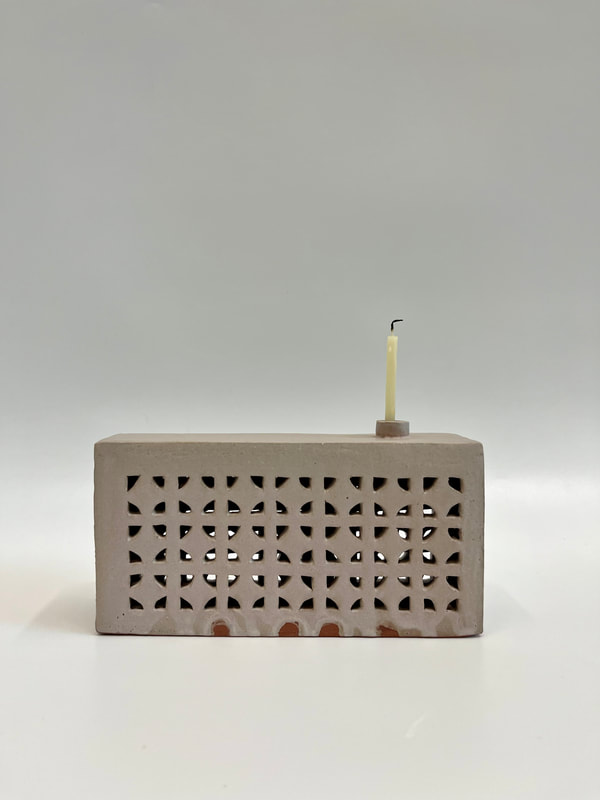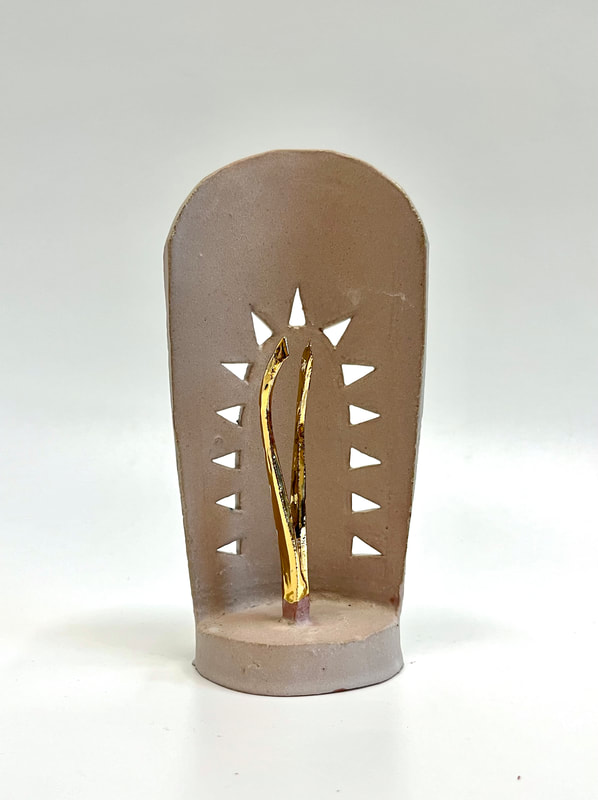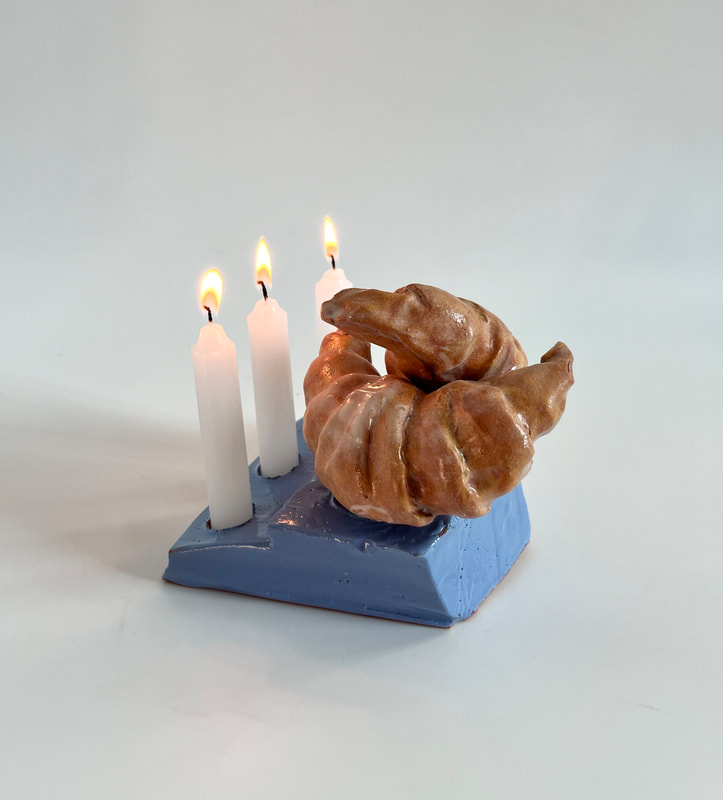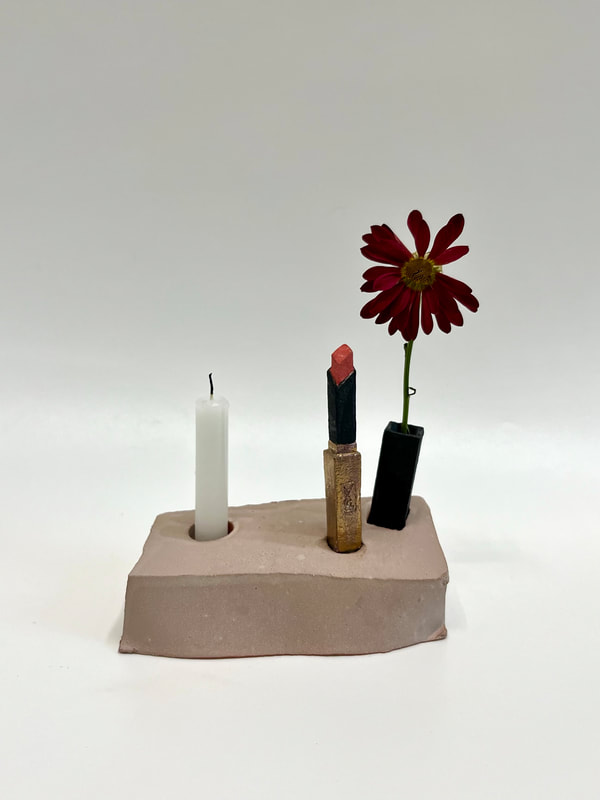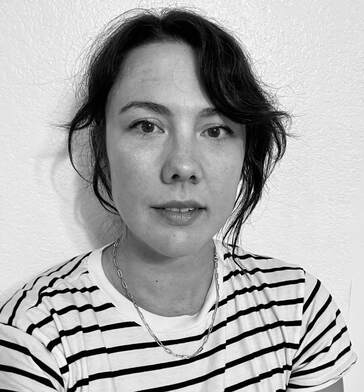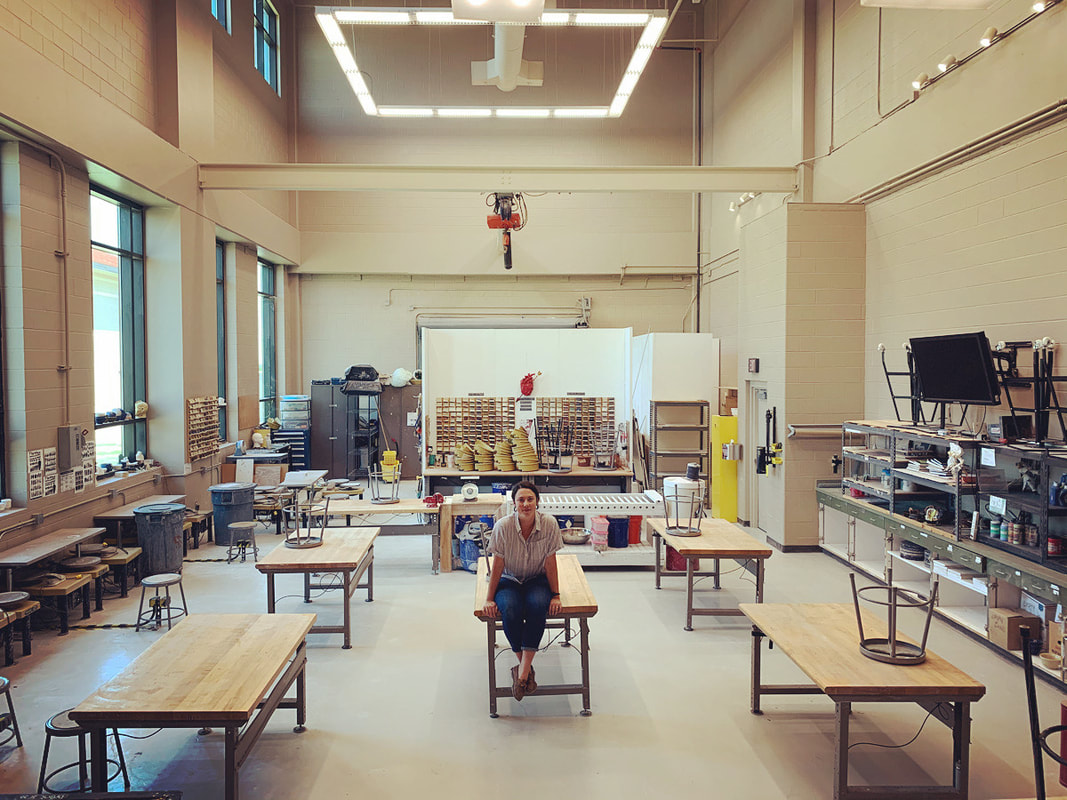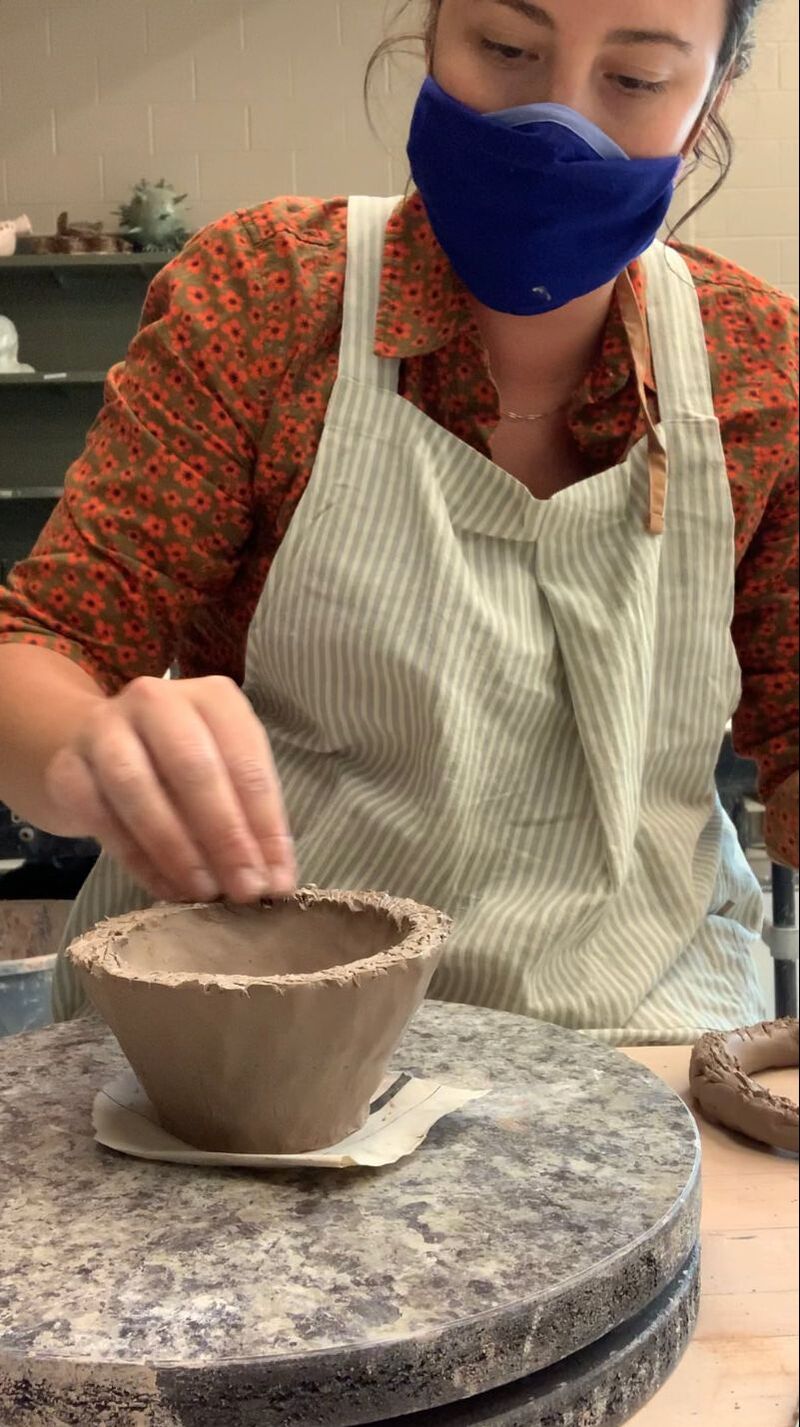Emily Bayless (b. 1988) is an artist who works primarily in clay to pursue the making of installation and objects. She received a BFA in ceramics from Arizona State University and an MFA in ceramics from the University of Colorado Boulder, and has expertise in hand building, wheel throwing, mold making, sculptural installation, kiln firing techniques, and surface decoration techniques. Bayless has been a guest lecturer at many institutions, including New Mexico State University, San Francisco Art Institute, Dickinson College, and Adams State University. Her work has been exhibited in museums and galleries, such as the Boulder Museum of Contemporary Art, Diego Rivera Gallery of SFAI, Baltimore Clay Works, Susquehanna Art Museum, and the Glave Kocen Gallery. The main areas of interest that currently preoccupy her studio research practice are the history of ceramics, gender equity, craft, and installation. Her work challenges the technical threshold of clay with pieces that are precarious, fragile, and stretch the stable scale of ceramic objects. Most recently Bayless completed a ceramic arch that contains 32 stacking pieces, culminating in an eight-foot-tall sculptural installation finished with a blue and white decorative motif that imitates the delft style of the 17th and 18th century.
Published on April 2nd 2021. Artist responses collected in months previous.
What hurdles have you overcome this year and how have they affected your art practice?
Since the last round of TWIRL interviews, I have accepted a new teaching position as Assistant Professor of Art at Texas A&M International University, teaching ceramics. This accomplishment is years in the making and feels especially rewarding during this time. The process of applying, interviewing, and traveling for career prospects is an intimidating process. Preparing my artist talk and delivering it in a formal interview setting has given me more confidence in my work and brought some ease to feeling vulnerable. I am by no means completely natural in a vulnerable state but the experience of exposing my work and teaching pedagogy so openly has taught me a lot. In the last year I also organized and curated an exhibition for the National Council on Education for the Ceramic Arts (NCECA) annual conference, which was accepted. This exhibition would have highlighted the work of 7 female identifying ceramic installation artists. The conference was inevitably cancelled due to the pandemic. I feel that this has taken some of the momentum away from my practice, feeling all that preparation lost and the general impact of the pandemic on my practice.
How has your art practice been affected by the pandemic?
COVID has shut down many programs, ended adjunct positions (a position I held through May of 2020), and completely changed educational priorities of colleges, universities, and students. When my previous institution went virtual in March of 2020, studio access went immediately to zero. I had not been able to work in clay for 6 months and it has felt like total stagnation. Recently I have gained studio access through my new institution, however the process of getting my own practice up and running will be slow. I've had time to work on classes and demos for my students, which has gotten my hands back in clay. I feel a stronger need to become independent and autonomous. Working through a community studio certainly has its advantages especially with access to equipment. However, my timeline to build a home studio has sped up, and that is a result of the pandemic. I have been able to focus more on fiber practices (knitting and sewing). But I wouldn't say I've adopted that as my art work, it's a practice that keeps my fingers and mind focused on making.
What support systems have you put in place to help keep your practice thriving amidst these unforeseeable circumstances?
Since accepting a new teaching position I now have the support of my currently institution to continue my research practice in the studio. I see this being a very mutually beneficial partnership and am looking forward to gaining some traction in this studio and community. I have an incredibly supportive partner who moved across the country with me so that I could accept this position. They have been one the most influential factors in my success through studio endeavors and career decisions. I have also started to work on a schedule every week (since starting the new position) which keeps me on track. My goal right now is to get my feet fully under me with teaching so that I can then put more focus on studio. My studio practice is not thriving right now, but I am implementing structures that I hope will get me back to that place.
What methods do you employ to stay resilient in your art practice? What tips would you recommend to other artists who find staying resilient difficult?
This is a difficult question to take on right now. I do not feel qualified to be passing out this advice. Maybe I don't feel resilient, and I feel inadequate to give an answer, because I haven't been able to work in clay. Maybe that's the answer. Work and just keep working. I think it's also important to try to keep your career path and studio practice in perspective, trying to keep comparison at bay. I find this difficult but it has been easier for me to quiet that judgmental voice by pursuing the things that make me feel fulfilled and celebrating that I can and often do feel fulfilled with the life I want to create. Therapeutic pursuits are also really important to my mental health, which I feel this question has a lot to do with. I've participated in therapy at various times in my life, but now I am finding that daily activities like yoga, running, or walking help me to stay grounded and focus on MY bigger picture. Wanderlust, by Rebecca Solnit, addresses, amongst many other things, how walking and moving our bodies helps to mentally work through things. I recommend reading her work.
What have you learned about yourself as an artist this year?
I have learned that my network of colleagues and friends in this field is bigger than I knew, and that I tend to underestimate myself. I have learned that I am better at advocating for myself than I knew and that this is a skill that must be practiced. I have learned that I like structure way more than I ever appreciated. Creating a schedule, organizing my space (home and studio), and backing up my laptop are things I try to do often that have helped me accomplish big goals this year. I have also realized that I carry a lot of baggage from my past. I find myself thinking about these things really often when I am working, especially personal relationships. This has always been part of me and it can easily be a detriment to my practice, or a distraction. I am learning how to ride the wave, let memories come and go, and continue onward.
What hurdles have you overcome this year and how have they affected your art practice?
Since the last round of TWIRL interviews, I have accepted a new teaching position as Assistant Professor of Art at Texas A&M International University, teaching ceramics. This accomplishment is years in the making and feels especially rewarding during this time. The process of applying, interviewing, and traveling for career prospects is an intimidating process. Preparing my artist talk and delivering it in a formal interview setting has given me more confidence in my work and brought some ease to feeling vulnerable. I am by no means completely natural in a vulnerable state but the experience of exposing my work and teaching pedagogy so openly has taught me a lot. In the last year I also organized and curated an exhibition for the National Council on Education for the Ceramic Arts (NCECA) annual conference, which was accepted. This exhibition would have highlighted the work of 7 female identifying ceramic installation artists. The conference was inevitably cancelled due to the pandemic. I feel that this has taken some of the momentum away from my practice, feeling all that preparation lost and the general impact of the pandemic on my practice.
How has your art practice been affected by the pandemic?
COVID has shut down many programs, ended adjunct positions (a position I held through May of 2020), and completely changed educational priorities of colleges, universities, and students. When my previous institution went virtual in March of 2020, studio access went immediately to zero. I had not been able to work in clay for 6 months and it has felt like total stagnation. Recently I have gained studio access through my new institution, however the process of getting my own practice up and running will be slow. I've had time to work on classes and demos for my students, which has gotten my hands back in clay. I feel a stronger need to become independent and autonomous. Working through a community studio certainly has its advantages especially with access to equipment. However, my timeline to build a home studio has sped up, and that is a result of the pandemic. I have been able to focus more on fiber practices (knitting and sewing). But I wouldn't say I've adopted that as my art work, it's a practice that keeps my fingers and mind focused on making.
What support systems have you put in place to help keep your practice thriving amidst these unforeseeable circumstances?
Since accepting a new teaching position I now have the support of my currently institution to continue my research practice in the studio. I see this being a very mutually beneficial partnership and am looking forward to gaining some traction in this studio and community. I have an incredibly supportive partner who moved across the country with me so that I could accept this position. They have been one the most influential factors in my success through studio endeavors and career decisions. I have also started to work on a schedule every week (since starting the new position) which keeps me on track. My goal right now is to get my feet fully under me with teaching so that I can then put more focus on studio. My studio practice is not thriving right now, but I am implementing structures that I hope will get me back to that place.
What methods do you employ to stay resilient in your art practice? What tips would you recommend to other artists who find staying resilient difficult?
This is a difficult question to take on right now. I do not feel qualified to be passing out this advice. Maybe I don't feel resilient, and I feel inadequate to give an answer, because I haven't been able to work in clay. Maybe that's the answer. Work and just keep working. I think it's also important to try to keep your career path and studio practice in perspective, trying to keep comparison at bay. I find this difficult but it has been easier for me to quiet that judgmental voice by pursuing the things that make me feel fulfilled and celebrating that I can and often do feel fulfilled with the life I want to create. Therapeutic pursuits are also really important to my mental health, which I feel this question has a lot to do with. I've participated in therapy at various times in my life, but now I am finding that daily activities like yoga, running, or walking help me to stay grounded and focus on MY bigger picture. Wanderlust, by Rebecca Solnit, addresses, amongst many other things, how walking and moving our bodies helps to mentally work through things. I recommend reading her work.
What have you learned about yourself as an artist this year?
I have learned that my network of colleagues and friends in this field is bigger than I knew, and that I tend to underestimate myself. I have learned that I am better at advocating for myself than I knew and that this is a skill that must be practiced. I have learned that I like structure way more than I ever appreciated. Creating a schedule, organizing my space (home and studio), and backing up my laptop are things I try to do often that have helped me accomplish big goals this year. I have also realized that I carry a lot of baggage from my past. I find myself thinking about these things really often when I am working, especially personal relationships. This has always been part of me and it can easily be a detriment to my practice, or a distraction. I am learning how to ride the wave, let memories come and go, and continue onward.
Find Emily Bayless on Instagram
